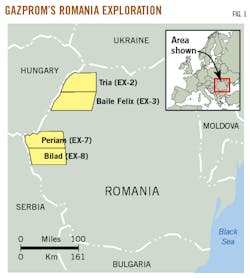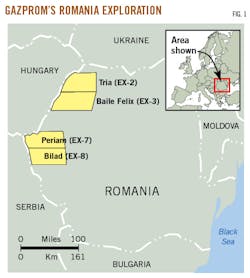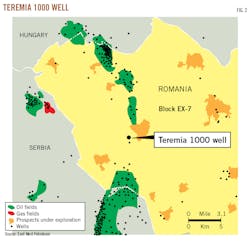NIS Gazprom Neft increases exploration in Romania
Slavko Nesic
NIS Gazprom Neft
Novi Sad, Serbia
Vladimir Mitrovic
University of Belgrade
Belgrade
NIS Gazprom Neft is planning 2019 onshore exploration in Romania on deep sections of conventional oil and gas reservoirs in metamorphous rocks and unconventional shales in Pannonian basin, where it has 25-year exploration licenses.
Previous exploration aimed at identifying shallow reservoirs. Crews will use recent seismic data, drilling information, and well test results from Serbia and Romania to make exploration decisions in Romania.
In nearby Serbia, the decline of oil and gas production has stabilized at 5-6% per year. Enhanced oil recovery and drilling infill wells have helped restore production from Serbia’s mature fields. NIS Gazprom is keen to develop Romanian oil discoveries to slow regional production decline.
Future development strategy will depend on exploration success in Serbia, Romania, Angola, and Bosnia.1
Pannonian basin is a heterogenous petroleum province with varied lithology. About 61% of hydrocarbon reservoirs are Neogene, 33% Paleozoic and Mesozoic, and 7% from Paleogene rocks. The Neogene units were the primary targets for oil and gas exploration.
Exploration results
As of early 2019, NIS had invested 100 million euros total on exploration in Romania, mostly on seismic surveying and drilling. The company said two exploration wells discovered eight new reservoirs.
Teremia 1000 well, the first well on Block EX-7, indicated possibilities for additional drilling to define discovered structures. Well tests of Teremia 1001 and Beba Veche South 1000 will guide additional exploration on EX-7.
Testing of Teremia 1001 and Beba Veche South 1000 awaited necessary permissions from government agencies as of early April.
Gazprom anticipates commercial oil production from EX-7 in 2021 although it acknowledges more investments are needed to construct processing units and pipelines.
NIS Gazprom Neft entered a joint venture with East West Petroleum Corp. of Canada. Together, the two companies are studying 900 sq km of 2D and 600 sq km of 3D seismic surveying.
The joint venture’s four onshore exploration blocks, Tria (EX-2), Balle Felix (EX-3), Periam (EX-7) and Biled (EX-8), cover 4,000 sq km in western Romania near Hungary and Serbia. Fig. 1 shows a map of the four blocks.
Joint venture terms call for NIS to cover 100% of exploration activities in the first phase in exchange for an 85% working interest, with East West Petroleum holding the balance.
Previous Romania exploration identified shallow reservoirs. The joint venture is focusing on deeper sections (OGJ, Oct. 2, 2013, p. 46). First-phase exploration consists of seismic surveying and drilling three wells in every block.
Around 500 oil and gas fields were discovered during previous exploration with primary production coming from Badenian and Sarmatian rocks and Upper Miocene sediments.2
In Romania, Pannonian basin systems involve Miocene oil-prone shales, shallow marine reservoirs, and upper Miocene sands. Most discoveries are in structural traps such as tilted faults. Due to the relatively thin, shallow sedimentary layers, late tilt of the basins, and volcanic gases, exploration risks are high in the Pannonian basin.
Previous exploration involved 2D seismic surveying and drilling relatively shallow wells up to 2-3 km deep, but deep structures were not explored. With 3D seismic surveying it is possible to extend the reach of exploration and define possible hydrocarbon accumulations in deeper structures of the Pannonian basin.3
Exploration activities
All of Gazprom’s exploration blocks are in northwestern Romania, 8 km from the border with Serbia, in the southeastern Pannonian basin. The area is characterized by Paleozoic, Miocene, Pliocene, and Quaternary rocks.
Paleozoic metamorphic rocks form the base of this sedimentary complex represented mostly by gneisses. Above the Paleozoic complex, there are Miocene sediments consisting of Lower Pontian rocks represented by marls and layers of sandstones, rarely shales, and Upper Pontian layers of consolidated sandstones, marlstones and shales, rarely with conglomerates and clays.
Pliocene and Quarternaty rocks are represented by sands, clays, marls, gravels, siltstones, coaly clays, and coals.
The joint venture plans to cover 400 sq km with seismic survey in 2019 in exploration blocks Tria (EX-2) and Balle Felix (EX-3). Seismic crews using 2D covered 95 km on Block EX-7 in early 2018.
Although the Romanian part of the Pannonian basin has been well covered by seismic surveying, unexplored regions remain, including some exploration blocks operated by NIS Gazprom Neft
Fig. 2 shows the Teremia 1000 well, drilled near the Serbian border. Teremia 1000 represents a Neogene anticline that covers a north-south-oriented basement prominence. The Teremia 1000 structure is along strike from several Serbian oil and gas fields involving Paleozic and Pontian formations.
Teremia 1000 tests demonstrated two intervals with naturally fractured metamorphic rocks. Light volatile oil flowed on test with gross rates up to 360 b/d and a water cut of 50%. Another five gas intervals in Miocene sediments individually tested with gross rates from 0.74-4.27 MMscf.
Gazprom completed Teremia 1000 but a final decision for commercial oil production will be considered after drilling and testing more appraisal wells in this block
Engineers expected to finish drilling appraisal well Teremia 1001 in May or June 2019. Teremia 1001 seeks to confirm oil and gas from the Teremia 1000 discovery, to determine production potential of the Upper and Lower Pontian sandstones, and to confirm Miocene oil and gas and naturally fractured Paleozoic metamorphic rocks.
Drilling on Beba Veche Sud 1000, 1 km from Serbia, also was expected to be finished in May or June 2019. The well location was determined using 2D and 3D seismic and knowledge gained from similar wells in Serbia. Beba Veche is on the southeastern Pannonian Plain, known for its oil and gas potential.
Gazprom seeks to confirm Paleozoic oil and gas at 3,500 m. It plans to drill another well on Block Biled (EX-8) during 2019 to evaluate other Teremia structures.
References
1. Gazprom Magazine interview with Kirill Tyurdenev, NIS general director, Dec. 4, 2018.
2. Dolton, G., “Pannonian Basin Province, Central Europe (Province 4808)—Petroleum Geology, Total Petroleum Systems, and Petroleum Resource Assessment,” US Department of the Interior US Geological Survey, 2006
3. Cristea, D. “An analogue study of sedimentary systems: West Iberian Basins vs East European Basins,” American Association of Petroleum Geologists European Regional Conference, May 2-3, 2018.
The authors
Slavko Nesic ([email protected]) is a NIS Gazprom Neft reservoir engineer. He worked on several enhanced oil recovery (EOR) projects in Serbia, including carbon dioxide sequestration and storage. He holds BS (2012) and MSc (2013) degrees in petroleum engineering from the University of Belgrade Faculty of Mining and Geology where he is completing his PhD. He participated in several research internships at the Institute of Arctic Petroleum Technologies at Gubkin University (Moscow) and has experience in reservoir engineering, reservoir management, and reservoir modelling.
Vladimir Mitrovic ([email protected]) is a petroleum engineering professor at the University of Belgrade. He has 40 years of experience in reservoir engineering research and teaching. He received BS (1976), MS (1986), and PhD (1991) degrees in petroleum engineering, all from the University of Belgrade. He collaborates with oil companies and governments on reservoir engineering, field development, and environmental analysis. He supervised reservoir engineering and oil development projects in Serbia for more than 30 years.


